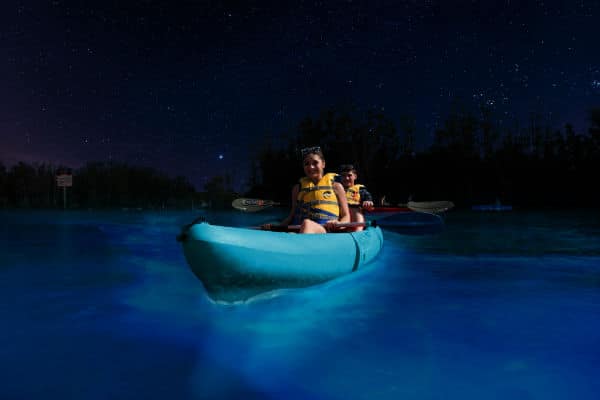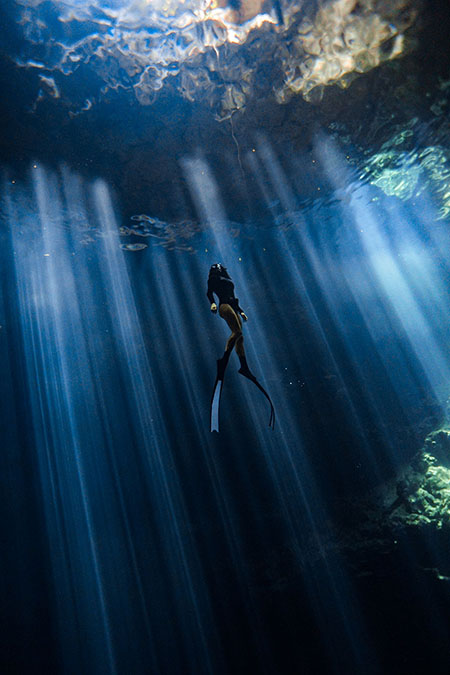Vistalocation Explorer: Uncovering the Ocean's Hidden Gems – Sustainable Sea Adventures Around the World

Hello, fellow ocean enthusiasts! I'm your Vistalocation Explorer, and my heart beats for the mesmerizing world beneath the waves. My mission? To seek out and share the most extraordinary, eco-conscious sea adventures our planet has to offer. I believe travel should enrich both our lives and the environment, not detract from it. That’s why I’m constantly searching for experiences that minimize our footprint and maximize our connection to the ocean's wonders. Today, I’m thrilled to unveil three unique, unforgettable journeys that perfectly embody this ethos: gliding through bioluminescent waters, exploring the depths of sacred cenotes, and witnessing the alien landscapes of hydrothermal vents. Join me as we dive into these incredible ecosystems, learning how we can explore them responsibly and protect them for generations to come. Because, let’s face it, these oceanic treasures are worth more than any fleeting thrill; they’re worth preserving.
1. Bioluminescent Kayaking in Mosquito Bay, Puerto Rico
Imagine yourself gliding silently through the darkness, the water beneath your kayak shimmering with an otherworldly glow. This isn’t a scene from a fantasy film; it’s the reality of kayaking in Mosquito Bay, Puerto Rico, one of the brightest bioluminescent bays on Earth. As your paddle dips into the water, millions of tiny organisms, called Dinoflagellates, light up in protest, creating a breathtaking spectacle of sparkling blue light. It’s like paddling through liquid stars!
The magic of Mosquito Bay lies in the unique combination of factors that allow these microorganisms to thrive. The bay is shallow, narrow, and surrounded by mangrove forests, which provide essential nutrients. These conditions, coupled with the warm water temperatures, create the perfect environment for the Dinoflagellates to multiply and create their mesmerizing light show.

However, this delicate ecosystem is under threat. Pollution from nearby development, increased boat traffic, and even light pollution can negatively impact the Dinoflagellates and diminish the bioluminescence. That’s why choosing a sustainable tour operator is crucial. I highly recommend [Insert specific tour operator name here]. They use eco-friendly kayaks, limit group sizes to minimize disturbance, and educate participants about the importance of protecting the bay.
Ethical Considerations:
- No Flash Photography: The bright light from flashes can disorient and harm the Dinoflagellates.
- Avoid Touching the Water: Oils and lotions from our skin can pollute the water and negatively impact the microorganisms.
- Stay on Designated Paths: Avoid disturbing the mangrove forests that are vital to the ecosystem.
Practical Information:
- Best Time to Visit: The darker the night, the better the bioluminescence. Aim for nights with a new moon.
- Required Gear: Most tour operators provide everything you need, but you may want to bring insect repellent.
- Tour Duration: Tours typically last around 1.5-2 hours.
- Booking: Book your tour in advance, especially during peak season.
2. Freediving in Cenotes, Yucatán, Mexico
Venture into the heart of the Yucatán Peninsula, and you'll discover a hidden world of breathtaking beauty: the cenotes. These freshwater sinkholes, formed by the collapse of limestone bedrock, were considered sacred by the Mayan people, who believed them to be gateways to the underworld. Today, they offer a unique and unforgettable freediving experience.
Imagine descending into the crystal-clear water, surrounded by stunning rock formations, stalactites, and stalagmites. Sunlight filters through the jungle canopy above, creating an ethereal glow that illuminates the underwater landscape. The water is cool and refreshing, offering a welcome respite from the tropical heat.
However, the cenotes are also fragile ecosystems, vulnerable to pollution from agricultural runoff, sewage, and tourism development. It’s essential to choose a tour operator committed to sustainable practices. I recommend [Insert specific tour operator name here]. They work closely with local communities, use biodegradable sunscreen, and educate divers about cenote conservation.
Ethical Considerations:
- Buoyancy Control: Proper buoyancy is crucial to avoid damaging the delicate cenote environment. Ensure you are properly weighted and avoid kicking up sediment.
- No Touching: Resist the urge to touch or disturb the formations. They are extremely fragile and take centuries to form.
- Respect Sacred Sites: Remember that the cenotes are culturally significant and should be treated with respect.
Practical Information:
- Best Time to Visit: The cenotes are open year-round, but the dry season (November-April) offers the best visibility.
- Required Gear: Mask, snorkel, fins, and a wetsuit (the water can be cool).
- Certifications: While not always required, a freediving certification will enhance your experience and ensure you are diving safely.
- Average Prices: Cenote tours range from $50-$150 USD, depending on the location and inclusions.
- Booking: Book your tour in advance, especially during peak season.
3. Submersible Exploration of Deep-Sea Hydrothermal Vents off the Coast of Iceland
For a truly extraordinary adventure, journey to the depths of the ocean in a submersible and witness the surreal landscape of hydrothermal vents. Located off the coast of Iceland, these vents are formed by volcanic activity on the seafloor. They spew out superheated, mineral-rich water, creating a unique environment that supports a bizarre array of life forms found nowhere else on Earth.
Imagine yourself inside a submersible, descending into the inky blackness of the deep sea. As you approach the hydrothermal vents, you'll be greeted by towering chimneys of sulfide minerals, pulsating with heat. Strange creatures, such as tube worms, blind shrimp, and anglerfish, thrive in this extreme environment, adapted to the high temperatures and toxic chemicals.
These deep-sea ecosystems are incredibly fragile and face threats from deep-sea mining and other forms of exploitation. It’s crucial to support tour operators who prioritize research and conservation. I recommend [Insert specific tour operator name here]. They partner with scientific institutions to conduct research during submersible dives and minimize their impact on the environment.

Ethical Considerations:
- Follow Strict Protocols: Adhere to all safety guidelines and instructions provided by the submersible crew.
- Minimize Disturbance: Avoid touching or disturbing the hydrothermal vent ecosystems.
- Support Research: Choose tour operators who contribute to scientific research and conservation efforts.
Practical Information:
- Duration: Submersible dives typically last several hours.
- Cost: Submersible dives are expensive, ranging from $5,000 to $10,000 USD per person.
- Prerequisites: A medical assessment may be required to ensure you are fit for the dive.
- Booking: Book your dive well in advance, as space is limited.
Ethical Dolphin Encounters in Bimini, Bahamas
For a chance to connect with incredible marine life, consider ethical dolphin encounters in Bimini, Bahamas. The key here is responsibility: ensuring the encounters are on the dolphins' terms. This means no chasing, feeding, or stressing them.
The Wild Dolphin Project has been researching and working to conserve these animals for years. Support tour operators that follow the guidelines they have established. Look for companies like [Insert Specific Tour Operator Name], known for respecting dolphin's natural behaviors.

Snorkeling with Whale Sharks in Ningaloo Reef, Australia
Snorkeling with whale sharks in Ningaloo Reef, Australia offers a truly breathtaking experience. Emphasize the importance of maintaining a safe and respectful distance, ensuring that you don't disrupt these gentle giants in their natural habitat. Look for tour operators that support conservation efforts and prioritize the well-being of these amazing creatures.
Seek out tour companies like [Insert Specific Tour Operator Name] that actively contribute to programs like the ECOCEAN whale shark monitoring program, demonstrating a commitment to research and conservation.

Conclusion
From the shimmering waters of bioluminescent bays to the alien landscapes of deep-sea hydrothermal vents, our planet offers an incredible array of sea adventures. But these treasures are not invulnerable. It’s our responsibility to explore them sustainably, support tour operators committed to conservation, and educate ourselves about the importance of protecting these fragile ecosystems.
I encourage you to seek out these incredible experiences and share your own suggestions for sustainable sea adventures in the comments below. Together, we can inspire a new generation of ocean stewards and ensure that these wonders are preserved for future generations. The ocean is calling, and it’s up to us to answer responsibly.